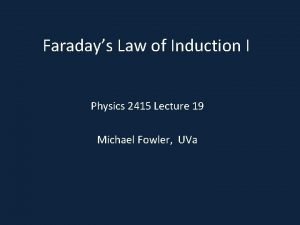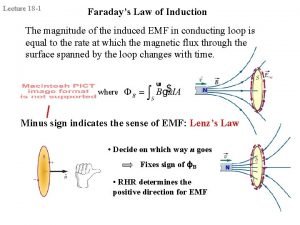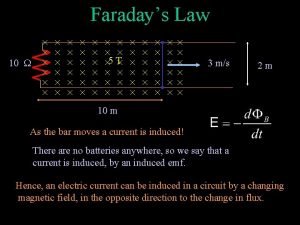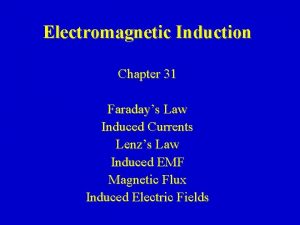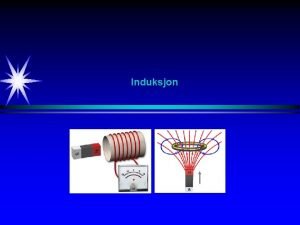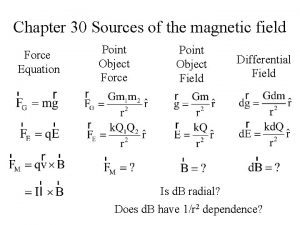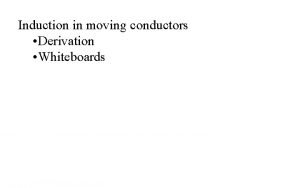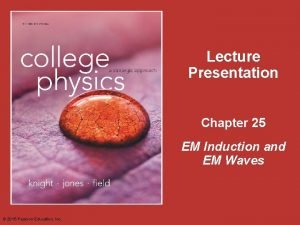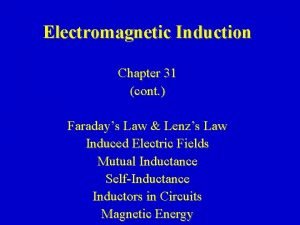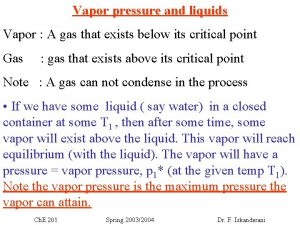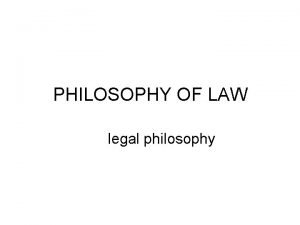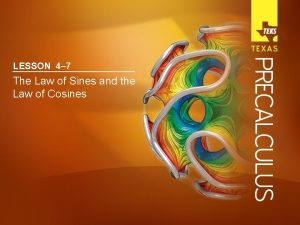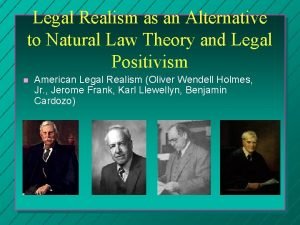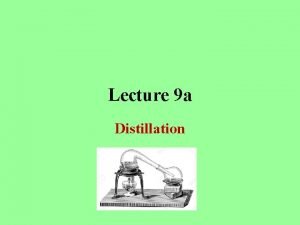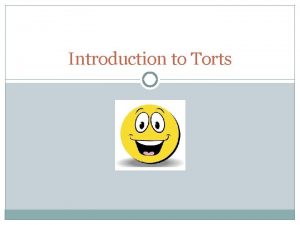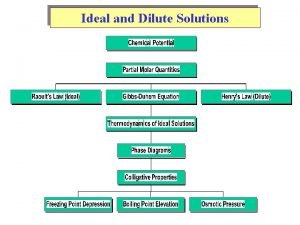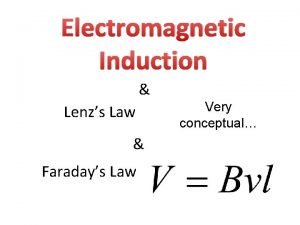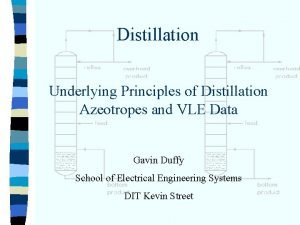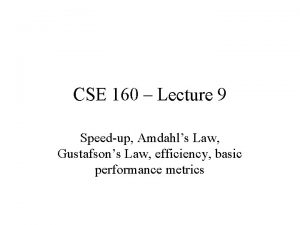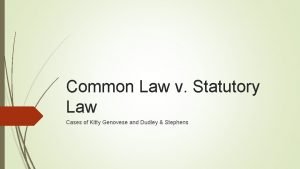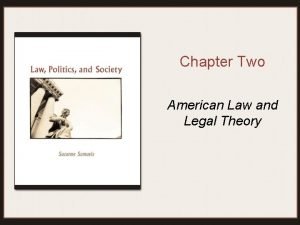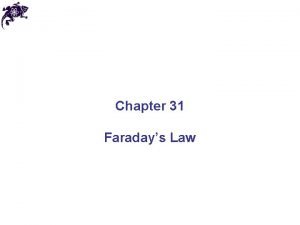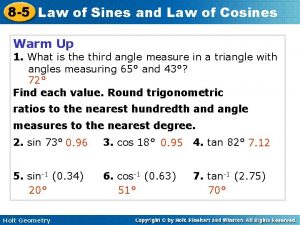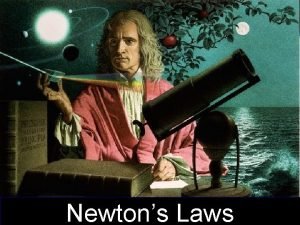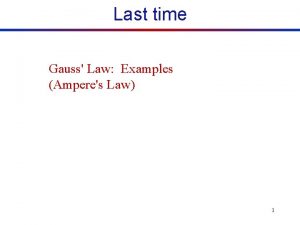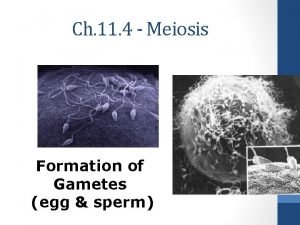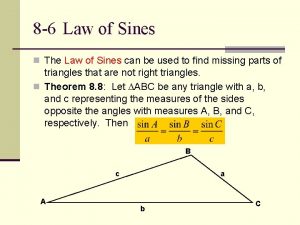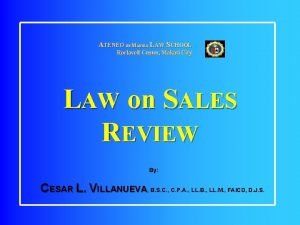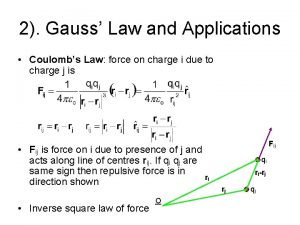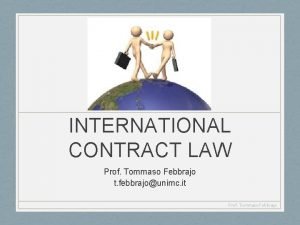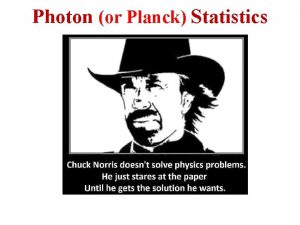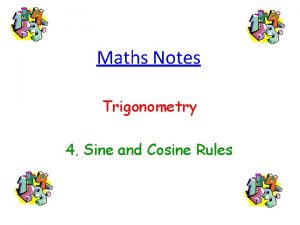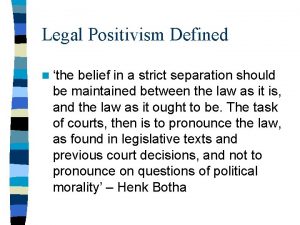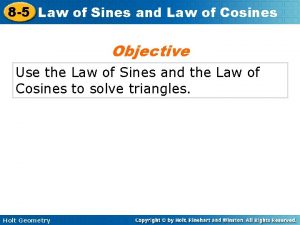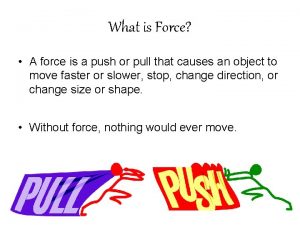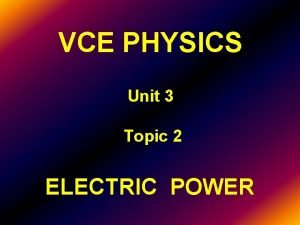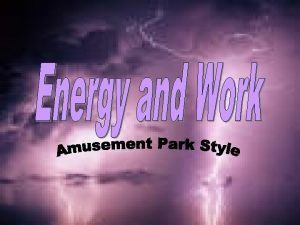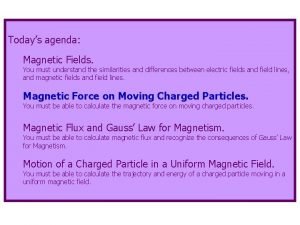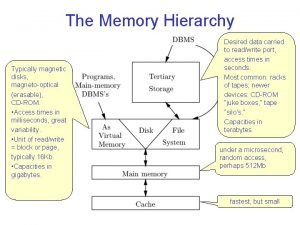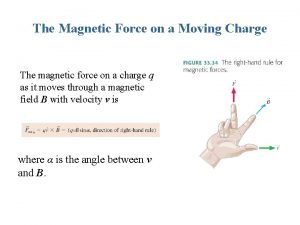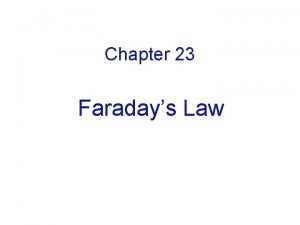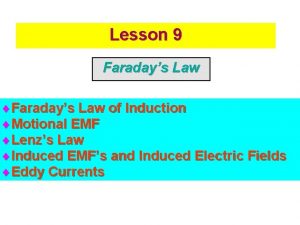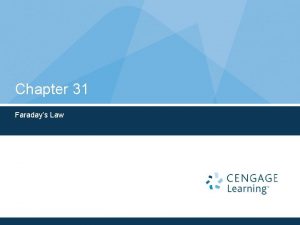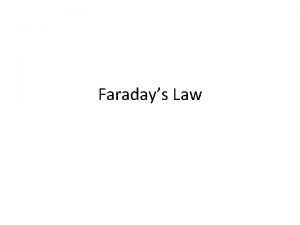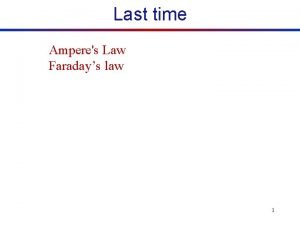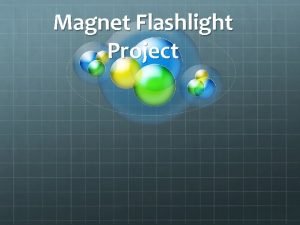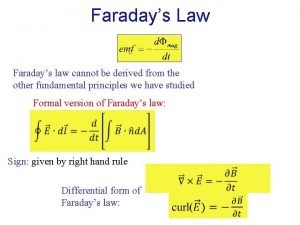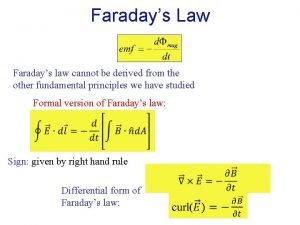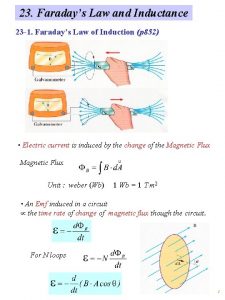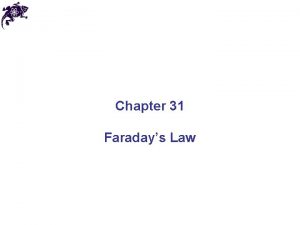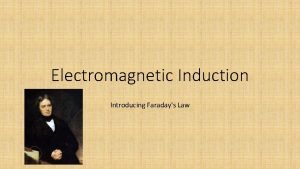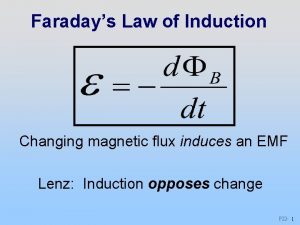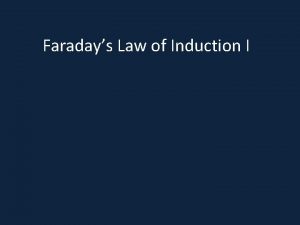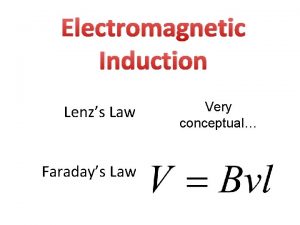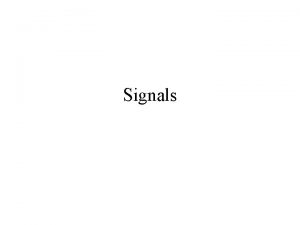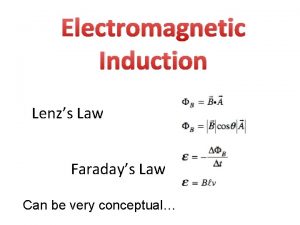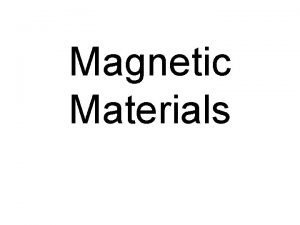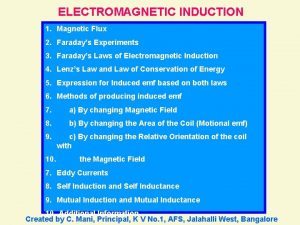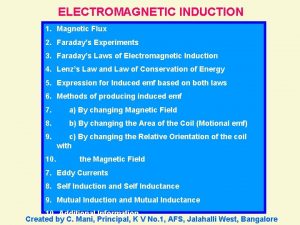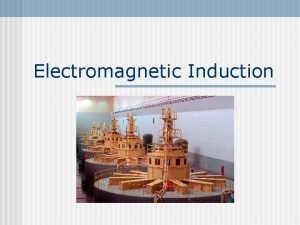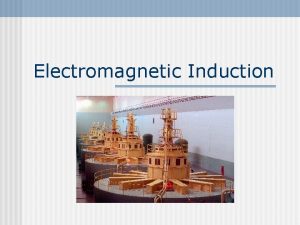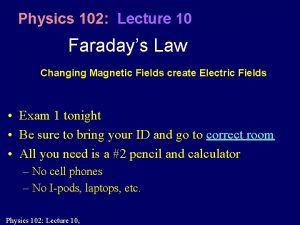Ch 21 Magnetic Induction Faradays Law of Induction
































































- Slides: 64

Ch. 21: Magnetic Induction & Faraday’s Law of Induction Copyright © 2009 Pearson Education, Inc.

Topics Outline • Induced EMF Faraday’s Law of Induction • Lenz’s Law • EMF Induced in a Moving Conductor • Electric Generators • Back EMF & Counter Torque Copyright © 2009 Pearson Education, Inc.

More Topics Eddy Currents Transformers & Transmission of Power Faraday’s Law: A Changing Magnetic Flux Produces an Electric Field! • Some Applications of Induction: Sound Systems, Computer Memory, Seismograph, …. Copyright © 2009 Pearson Education, Inc.

Magnetic Induction • Electric & magnetic forces both act only on particles carrying an electric charge • Ch. 20: Moving electric charges create a magnetic field • Ch. 21 (now!): A changing magnetic field creates an electric field – This effect is called magnetic induction – This links electricity and magnetism in a fundamental way • Magnetic induction is also the key to many practical applications. See next slides! Copyright © 2009 Pearson Education, Inc.

Some Applications Magnetic Resonance Imaging (MRI) Speedometers & Odometers Copyright © 2009 Pearson Education, Inc.

Electric Guitars & Other Instruments Copyright © 2009 Pearson Education, Inc.

Hybrid Automobiles Copyright © 2009 Pearson Education, Inc.

Electromagnetism • Electric and magnetic phenomena were first connected by Ørsted in 1820 • He discovered that an electric current in a wire can exert a force on a compass needle. – We just saw this in the last chapter. • This indicates that an electric field can lead to a force on a magnet. – We just saw this in the last chapter • He concluded that An electric field can produce a magnetic field Copyright © 2009 Pearson Education, Inc.

An electric field can produce a magnetic field Copyright © 2009 Pearson Education, Inc.

An electric field can produce a magnetic field • Eventually, this led to the question: Can a magnetic field produce an electric field? Copyright © 2009 Pearson Education, Inc.

An electric field can produce a magnetic field • Eventually, this led to the question: Can a magnetic field produce an electric field? • Experiments by Michael Faraday found that the answer is yes! Copyright © 2009 Pearson Education, Inc.

Michael Faraday 1791 – 1867 • British physicist & Chemist. • Great experimental Scientist. • A “hands” on Experimental Scientist. Strong on experiment design. Less strong on math! 2 of his Major Contributions to Electricity: 1. Electromagnetic induction 2. Laws of electrolysis (Chemistry) Copyright © 2009 Pearson Education, Inc.

Michael Faraday A Productive Inventor!!! Some Major Inventions 1. Motor 2. Generator 3. Transformer Copyright © 2009 Pearson Education, Inc.

Faraday’s Discoveries: 1. Whenever the magnetic field about an electromagnet was made to grow or collapse by closing or opening the electric circuit of which it was a part, an electric current could be detected in a separate conductor nearby. Copyright © 2009 Pearson Education, Inc.

Faraday’s Discoveries: 2. Moving a permanent magnet into & out of a coil of wire also induces a current in the wire while the magnet is moving. 3. Moving a conductor near a stationary permanent magnet causes a current to flow in the wire also, as long as it is moving. Copyright © 2009 Pearson Education, Inc.

Faraday’s Experiments • Faraday attempted to observe a B field-induced E field – He used an ammeter instead of a light bulb • If the bar magnet was in motion, a current was observed • If the magnet was stationary, the current & the electric field were both zero Copyright © 2009 Pearson Education, Inc.

Another Faraday Experiment • A solenoid is positioned near a loop of wire with the light bulb. Current passes through the solenoid by connecting it to a battery. When the current through the solenoid is constant, there is no current in the wire. When the switch is opened or closed, the bulb lights up. Copyright © 2009 Pearson Education, Inc.

Induced EMF • Faraday looked for evidence that a magnetic field would induce an electric current with this apparatus: Copyright © 2009 Pearson Education, Inc.

• He found no evidence when the current was steady. But, he saw an induced current when the switch was turned on or off. Copyright © 2009 Pearson Education, Inc.

Faraday concluded that: A Changing Magnetic Field Induces an EMF. • His experiments used a magnetic field that was changing because the current producing it was changing; the picture shows a magnetic field that changes because the magnet is moving. Copyright © 2009 Pearson Education, Inc.

An EMF is Produced by a Changing Magnetic Field • A loop of wire is connected to a sensitive ammeter. • When a magnet is moved toward the loop, the ammeter deflects. – The direction was arbitrarily chosen to be negative. Copyright © 2009 Pearson Education, Inc.

• When the magnet is held stationary, there is no deflection of the ammeter. • Therefore, there is no induced current. – Even though the magnet is in the loop Copyright © 2009 Pearson Education, Inc.

• If the magnet is moved away from the loop. • The ammeter deflects in the opposite direction! Copyright © 2009 Pearson Education, Inc.

Induced Current, Summary Copyright © 2009 Pearson Education, Inc.

Faraday’s Experiment – Set Up • A primary coil is connected to a switch and a battery. • The wire is wrapped around an iron ring. • A secondary coil is also wrapped around the iron ring. No battery is present in the secondary coil. • The secondary coil is not directly connected to the primary coil. Copyright © 2009 Pearson Education, Inc.

Close the switch & observe the current readings on the ammeter. Copyright © 2009 Pearson Education, Inc.

Faraday’s Findings • At the instant the switch is closed, the ammeter changes from zero in one direction, then returns to zero. • When the switch is opened, the ammeter changes in the opposite direction, then returns to zero. • The ammeter reads zero when there is a steady current or when there is no current in the primary circuit. Copyright © 2009 Pearson Education, Inc.

Faraday’s Experiments: Conclusions 1. An electric current can be induced in a loop by a changing magnetic field. –This is the current in the secondary circuit of this experimental set-up. 2. The induced current exists only while the magnetic field through the loop is changing. Copyright © 2009 Pearson Education, Inc.

Faraday’s Experiments: Conclusions 3. An electric current is induced in a secondary circuit during the time when the current through the solenoid is changing. Faraday’s experiments show that an electric current is produced in the wire loop only when the magnetic field at the loop is changing A changing magnetic field produces an electric field Copyright © 2009 Pearson Education, Inc.

Faraday’s Experiments: Conclusions A changing magnetic field produces an electric field • An electric field produced in this way is called an induced electric field. • This phenomena is called electromagnetic induction Copyright © 2009 Pearson Education, Inc.

Faraday’s Experiment: Conclusions • All of this is usually expressed as: An induced emf is produced in the loop by the changing magnetic field. • Just the existence of the magnetic field is not sufficient to produce the induced emf, the field must be changing. Copyright © 2009 Pearson Education, Inc.

Magnetic Flux • Faraday developed a quantitative theory of induction that is now called Faraday’s Law – This law shows how to calculate the induced electric field in different situations • Faraday’s Law uses the concept of magnetic flux – Magnetic flux is similar to the concept of electric flux • Let A be an area of a surface with a magnetic field passing through it • The flux is defined as ΦB B A cos θ Copyright © 2009 Pearson Education, Inc.

Magnetic Flux • If the field is perpendicular to the surface, ΦB = B A • If the field makes an angle θ with the normal to the surface, ΦB = B A cos θ • If the field is parallel to the surface, ΦB = 0 Copyright © 2009 Pearson Education, Inc.

• The magnetic flux can be defined for any surface – A complicated surface can be broken into small regions and the definition of flux applied – The total flux is the sum of the fluxes through all the individual pieces of the surface • The surfaces of interest are open surfaces – With electric flux, closed surfaces were used • SI unit of magnetic flux = the Weber (Wb) 1 Wb = 1 T. m 2 Copyright © 2009 Pearson Education, Inc.

Faraday’s Law of Induction: Lenz’s Law • Faraday found that the induced emf in a wire loop is Proportional to the time Rate of Change of the Magnetic Flux Through the Loop. • Magnetic Flux is defined similarly to electric flux: If B is constant over a surface area A, then the magnetic flux passing through A is ΦB B A = BA cosθ (The scalar or dot product of vectors B & A) • The SI Unit of Magnetic flux = Weber (Wb): 1 Wb = 1 T·m 2. Copyright © 2009 Pearson Education, Inc.

This figure shows the variables in the flux equation: ΦB = B A = BA cosθ Copyright © 2009 Pearson Education, Inc.

• Magnetic Flux is analogous to electric flux: It is proportional to the total number of magnetic field lines passing through the loop. Copyright © 2009 Pearson Education, Inc.

Conceptual Example: Determining Flux • A square loop of wire encloses area A 1. A uniform magnetic field B perpendicular to the loop extends over the area A 2. • What is the magnetic flux through the loop A 1? Copyright © 2009 Pearson Education, Inc.

Faraday’s Law of Induction: “The emf induced in a circuit is equal to the negative of the time rate of change of magnetic flux through the circuit. ” For a coil of N turns: N Copyright © 2009 Pearson Education, Inc.

Faraday’s Law, Summary Only changes in the magnetic flux matter • Rapid changes in the flux produce larger values of emf than do slow changes • This dependence on frequency means the induced emf plays an important role in AC circuits • The magnitude of the emf is proportional to the rate of change of the flux Copyright © 2009 Pearson Education, Inc.

Faraday’s Law, Summary • The magnitude of the induced emf is proportional to the rate of change of the flux • If the rate is constant, then the emf is constant • In most cases, this isn’t possible and AC currents result • The induced emf is present even if there is no current in the path enclosing an area of changing magnetic flux Copyright © 2009 Pearson Education, Inc.

Flux Though a Changing Area • A magnetic field is constant and in a direction perpendicular to the plane of the rails and the bar. • Assume the bar moves at a constant speed. • The magnitude of the induced emf is ε = B L v • The current leads to power dissipation in the circuit Copyright © 2009 Pearson Education, Inc.

Conservation of Energy • The mechanical power put into the bar by the external agent is equal to the electrical power delivered to the resistor • Energy is converted from mechanical to electrical, but the total energy remains the same • Conservation of energy is obeyed by electromagnetic phenomena Copyright © 2009 Pearson Education, Inc.

• The minus sign gives the direction of the induced emf. Lenz’s Law: A current produced by an induced emf moves in a direction so that the magnetic field IT PRODUCES tends to restore the changed field. Copyright © 2009 Pearson Education, Inc.

• The minus sign gives the direction of the induced emf. Lenz’s Law: Alternative Statement: An induced emf is always in a direction that OPPOSES the original change in flux that caused it. Copyright © 2009 Pearson Education, Inc.

Lenz’s Law • Lenz’s Law gives a way to determine the sign of the induced emf • Lenz’s Law states that the magnetic field produced by an induced current always opposes any changes in the magnetic flux Copyright © 2009 Pearson Education, Inc.

Lenz’s Law, Example 1 • Assume a metal loop in which the magnetic field passes upward through it. Assume the magnetic flux increases with time. • The magnetic field produced by the induced emf must oppose the change in flux. So, the induced magnetic field must be downward and the induced current will be clockwise Copyright © 2009 Pearson Education, Inc.

Lenz’s Law, Example 2 • Assume a metal loop in which the magnetic field passes upward through it. Assume the magnetic flux decreases with time. • The magnetic field produced by the induced emf must oppose the change in flux. So, the induced magnetic field must be upward and the induced current will be counterclockwise Copyright © 2009 Pearson Education, Inc.

Example • Assume a loop enclosing an area A that lies in a uniform magnetic field. • The magnetic flux through the loop is ΦB = B A = BAcos(θ) • The induced emf is = - ( [BAcos(θ)]/ t) Copyright © 2009 Pearson Education, Inc.

Methods of Inducing an EMF Using Faraday’s Law • The magnitude of the magnetic field can change with time. • The area enclosed by the loop can change with time. • The angle between the magnetic field & the normal to the loop can change with time. • Any combination of the above can occur. Copyright © 2009 Pearson Education, Inc.

Changing a Magnetic Flux, Summary Copyright © 2009 Pearson Education, Inc.

Example A Loop of Wire in a Magnetic Field • A square loop of wire of side l = 5. 0 cm is in a uniform magnetic field B = 0. 16 T. Calculate (a) The magnetic flux in the loop when B is perpendicular to the face of the loop. (b) The magnetic flux in the loop when B is at an angle of 30° to the area A of the loop, (c) The magnitude of the average current in the loop if it has a resistance of R = 0. 012 Ω and it is rotated from position (b) to position (a) in 0. 14 s. Copyright © 2009 Pearson Education, Inc.

Example A Loop of Wire in a Magnetic Field • Square loop l = 5. 0 cm, uniform magnetic field B = 0. 16 T. • A = l 2 = 2. 5 10 -3 m 2 In general, ΦB = B A = BAcos(θ) (a) Magnetic flux when B is perpendicular to face of loop. = 90°, cos (90°) = 1 ΦB = (0. 16)(2. 5 10 -3) = 4. 0 10 -4 Wb Copyright © 2009 Pearson Education, Inc.

Example A Loop of Wire in a Magnetic Field • Square loop l = 5. 0 cm, uniform magnetic field B = 0. 16 T. • A = l 2 = 2. 5 10 -3 m 2 In general, ΦB = B A = BAcos(θ) (a) Magnetic flux when B is perpendicular to face of loop. = 90°, cos (90°) = 1 ΦB = (0. 16)(2. 5 10 -3) = 4. 0 10 -4 Wb (b) The magnetic flux in the loop when B is at an angle of 30° to the area A of the loop cos(30°) = 0. 866 ΦB = (0. 16)(2. 5 10 -3)(0. 866) = 3. 5 10 -4 Wb Copyright © 2009 Pearson Education, Inc.

Example A Loop of Wire in a Magnetic Field • Square loop l = 5. 0 cm, uniform magnetic field B = 0. 16 T. • A = l 2 = 2. 5 10 -3 m 2 In general, ΦB = B A = BAcos(θ) (a) Magnetic flux when B is perpendicular to face of loop. = 90°, cos (90°) = 1 ΦB = (0. 16)(2. 5 10 -3) = 4. 0 10 -4 Wb (b) The magnetic flux in the loop when B is at an angle of 30° to the area A of the loop cos(30°) = 0. 866 ΦB = (0. 16)(2. 5 10 -3)(0. 866) = 3. 5 10 -4 Wb (c) The magnitude of the average current in the loop of resistance R = 0. 012 Ω & it is rotated from position (b) to position (a) in t = 0. 14 s. B = (3. 5 -4. 0) 10 -4 Wb = -5 10 -5 Wb = - ( B/ t) = (5 10 -5)/(0. 14) = 3. 6 10 -4 V Copyright © 2009 Pearson Education, Inc.

Example A Loop of Wire in a Magnetic Field • Square loop l = 5. 0 cm, uniform magnetic field B = 0. 16 T. • A = l 2 = 2. 5 10 -3 m 2 In general, ΦB = B A = BAcos(θ) (a) Magnetic flux when B is perpendicular to face of loop. = 90°, cos (90°) = 1 ΦB = (0. 16)(2. 5 10 -3) = 4. 0 10 -4 Wb (b) The magnetic flux in the loop when B is at an angle of 30° to the area A of the loop cos(30°) = 0. 866 ΦB = (0. 16)(2. 5 10 -3)(0. 866) = 3. 5 10 -4 Wb (c) The magnitude of the average current in the loop of resistance R = 0. 012 Ω & it is rotated from position (b) to position (a) in t = 0. 14 s. B = (3. 5 -4. 0) 10 -4 Wb = -5 10 -5 Wb = - ( B/ t) = (5 10 -5)/(0. 14) = 3. 6 10 -4 V So, I = ( /R) = (3. 6 10 -4 V)/(0. 14) = 2. 6 10 -3 A Copyright © 2009 Pearson Education, Inc.

The Magnetic Flux will change if the area of the loop changes. Copyright © 2009 Pearson Education, Inc.

Magnetic Flux will change if the angle between the loop & the field changes. Copyright © 2009 Pearson Education, Inc.

Application: Induction stove. In an induction stove, an ac current exists in a coil that is the “burner” (a burner that never gets hot). Why will it heat a metal pan but not a glass container? Copyright © 2009 Pearson Education, Inc.

Problem Solving: Lenz’s Law 1. Determine whether the magnetic flux is increasing, decreasing, or unchanged. 2. The magnetic field due to the induced current points in the opposite direction to the original field if the flux is increasing; in the same direction if it is decreasing; and is zero if the flux is not changing. 3. Use the right-hand rule to determine the direction of the current. 4. Remember that the external field and the field due to the induced current are different. Copyright © 2009 Pearson Education, Inc.

Conceptual Example: Practice with Lenz’s Law In which direction is the current induced in the circular loop for each situation? Copyright © 2009 Pearson Education, Inc.

Conceptual Example: Practice with Lenz’s Law In which direction is the current induced in the circular loop for each situation? Copyright © 2009 Pearson Education, Inc.

Example (Giancoli, p 764) Pulling a coil from a magnetic field. • A 100 -loop square coil of wire, with side l = 5. 00 cm & total resistance 100 Ω, is positioned perpendicular to a uniform 0. 600 -T magnetic field. It is quickly pulled from the field at constant speed (moving perpendicular to B) to a region where B drops to zero. Copyright © 2009 Pearson Education, Inc.

Example: N = 100, l = 0. 05 m, R= 100 Ω, B = 0. 6 T • At t = 0, the right edge of the coil is at the edge of the field. It takes t = 0. 1 s for the whole coil to reach the field-free region. Find: (a) the rate of change in flux through the coil, (b) the emf and current induced. (c) the energy dissipated in the coil. (d) the average force required (Fext). Copyright © 2009 Pearson Education, Inc.
 Lenz law
Lenz law Faradays law
Faradays law Faradays law
Faradays law Change in magnetic flux formula
Change in magnetic flux formula Faraday's constant
Faraday's constant Magneten fluks
Magneten fluks Confidential
Confidential Magnetic flux formula with current
Magnetic flux formula with current Magnetic moment and magnetic field relation
Magnetic moment and magnetic field relation Force on charged particle
Force on charged particle Newton's first law and second law and third law
Newton's first law and second law and third law Newton's first law and second law and third law
Newton's first law and second law and third law Boyle's law charles law avogadro's law
Boyle's law charles law avogadro's law Avogadro's law constants
Avogadro's law constants Magnetostatic field
Magnetostatic field Explain faraday's experiment of electromagnetic induction
Explain faraday's experiment of electromagnetic induction Faraday's law of electromagnetic induction ppt
Faraday's law of electromagnetic induction ppt Faraday's law of electromagnetic induction
Faraday's law of electromagnetic induction Raoult's law and dalton's law
Raoult's law and dalton's law Difference between civil law and criminal law
Difference between civil law and criminal law Natural law vs positive law
Natural law vs positive law Natural law vs positive law
Natural law vs positive law Positive law vs natural law
Positive law vs natural law Law of dominance
Law of dominance 4-7 law of sines and cosines
4-7 law of sines and cosines Positive law vs natural law
Positive law vs natural law Introduction of distillation
Introduction of distillation Criminal law plaintiff
Criminal law plaintiff Raoult's law and dalton's law
Raoult's law and dalton's law Law of segregation and independent assortment
Law of segregation and independent assortment Faraday's law vs lenz's law
Faraday's law vs lenz's law Ethanol azeotrope
Ethanol azeotrope Gustafson's law
Gustafson's law Difference between statute and common law
Difference between statute and common law Common law australia
Common law australia Positive law vs natural law
Positive law vs natural law Lenz law
Lenz law Natural law vs positive law
Natural law vs positive law Private law vs public law
Private law vs public law Quiz 8-3 law of sines and law of cosines
Quiz 8-3 law of sines and law of cosines Raoult's law for non volatile solute
Raoult's law for non volatile solute Cosa afferma la legge di gravitazione universale
Cosa afferma la legge di gravitazione universale Amperes law example
Amperes law example Independent assortment in meiosis
Independent assortment in meiosis 8-6 the law of sines and law of cosines
8-6 the law of sines and law of cosines Law is order and good law is good order
Law is order and good law is good order Pactum commissorium meaning philippine law
Pactum commissorium meaning philippine law How to use coulomb's law
How to use coulomb's law Common law and civil law
Common law and civil law Common law and civil law
Common law and civil law Tommaso febbrajo
Tommaso febbrajo Law of independent assortment vs law of segregation
Law of independent assortment vs law of segregation R in coulomb's law
R in coulomb's law Rayleigh-jeans law
Rayleigh-jeans law Sine and cosine rule
Sine and cosine rule Natural law vs positivism
Natural law vs positivism 8-5 law of sines
8-5 law of sines Gravity force
Gravity force Right hand palm rule magnetic field
Right hand palm rule magnetic field True north vs magnetic north
True north vs magnetic north Types of magnetic energy
Types of magnetic energy Magnitude of magnetic force
Magnitude of magnetic force Electric field and magnetic field difference
Electric field and magnetic field difference Magnetic disk in memory hierarchy
Magnetic disk in memory hierarchy Integral of magnetic field
Integral of magnetic field
